Health Promotion: Planning and Implementation - Comprehensive Report
VerifiedAdded on 2023/06/10
|11
|3395
|133
Report
AI Summary
This report delves into the crucial aspects of health promotion, focusing on planning and implementation strategies. It begins by exploring the Precede-Proceed model as a systematic framework for health promotion efforts, emphasizing its role in assessing needs and designing interventions. The report then identifies key partners and stakeholders involved in public health programs, including government, pharmaceuticals, and community organizations, highlighting their respective roles in promoting well-being. Furthermore, the report discusses the significance of quality in healthcare, referencing quality models like Lean and Six Sigma, and illustrates their application through the example of a quality care team. It also examines the concept of commissioning in health promotion and the value of effective communication in delivering successful programs. Finally, the report underscores the importance of good teamwork in ensuring the success of health promotion projects, alongside other critical factors.
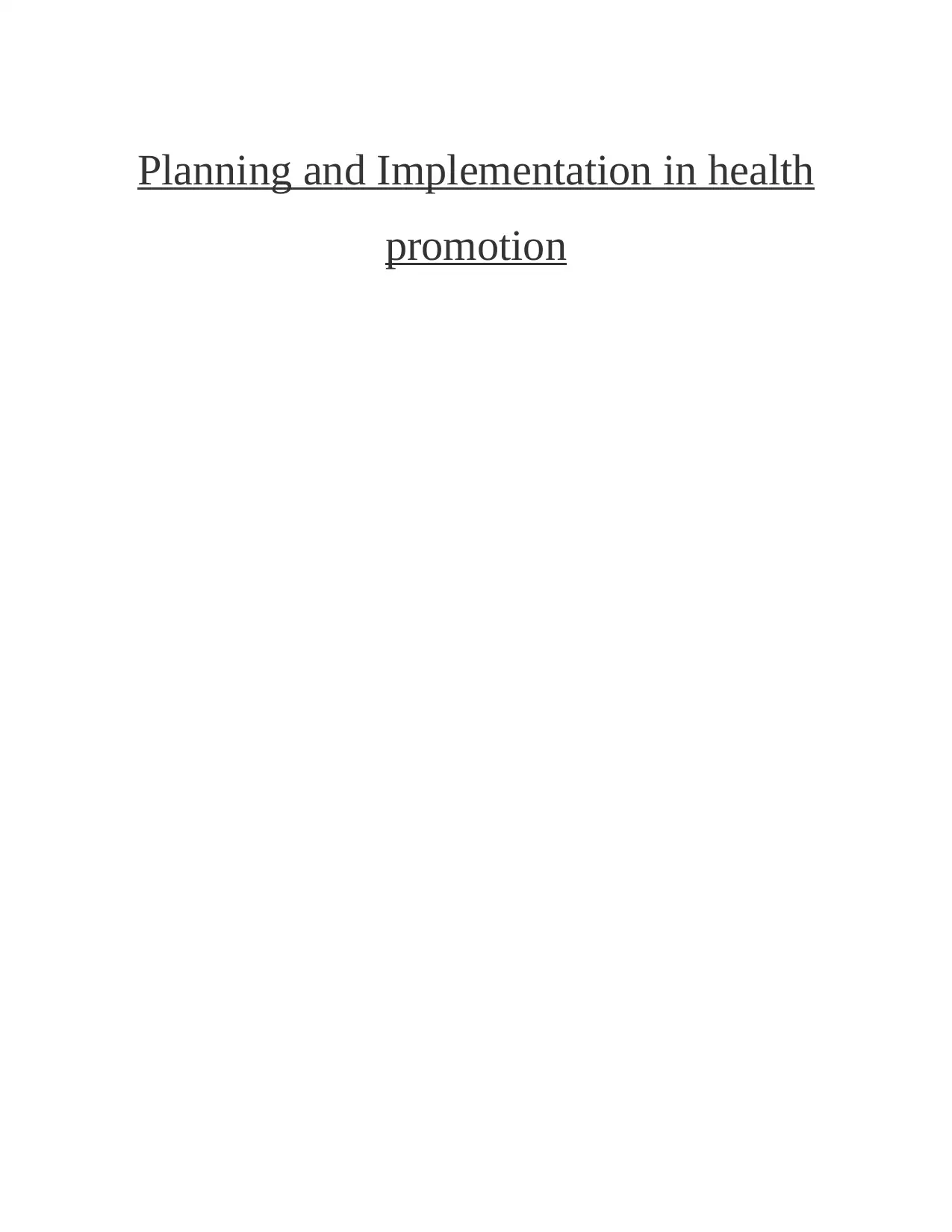
Planning and Implementation in health
promotion
promotion
Paraphrase This Document
Need a fresh take? Get an instant paraphrase of this document with our AI Paraphraser
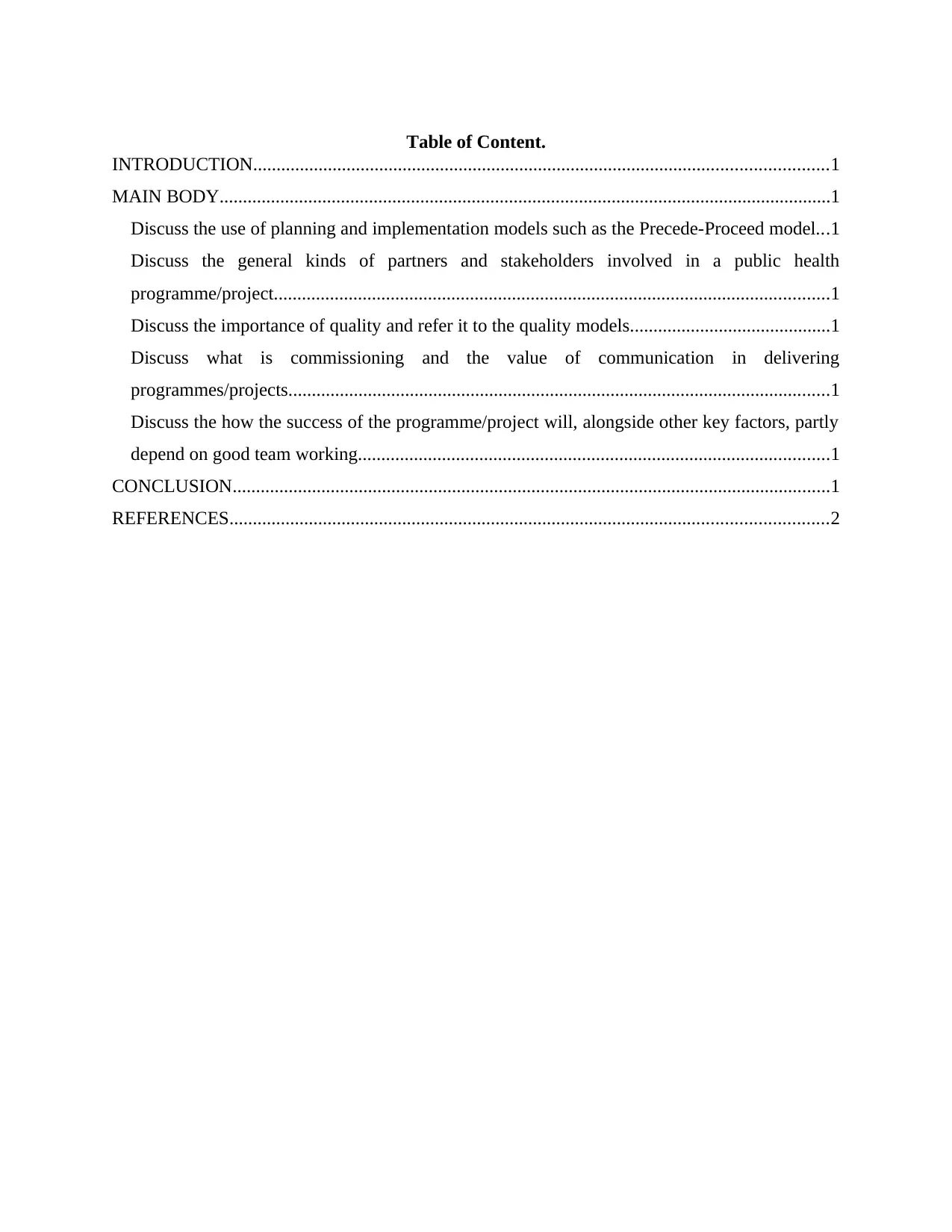
Table of Content.
INTRODUCTION...........................................................................................................................1
MAIN BODY...................................................................................................................................1
Discuss the use of planning and implementation models such as the Precede-Proceed model...1
Discuss the general kinds of partners and stakeholders involved in a public health
programme/project.......................................................................................................................1
Discuss the importance of quality and refer it to the quality models...........................................1
Discuss what is commissioning and the value of communication in delivering
programmes/projects....................................................................................................................1
Discuss the how the success of the programme/project will, alongside other key factors, partly
depend on good team working.....................................................................................................1
CONCLUSION................................................................................................................................1
REFERENCES................................................................................................................................2
INTRODUCTION...........................................................................................................................1
MAIN BODY...................................................................................................................................1
Discuss the use of planning and implementation models such as the Precede-Proceed model...1
Discuss the general kinds of partners and stakeholders involved in a public health
programme/project.......................................................................................................................1
Discuss the importance of quality and refer it to the quality models...........................................1
Discuss what is commissioning and the value of communication in delivering
programmes/projects....................................................................................................................1
Discuss the how the success of the programme/project will, alongside other key factors, partly
depend on good team working.....................................................................................................1
CONCLUSION................................................................................................................................1
REFERENCES................................................................................................................................2
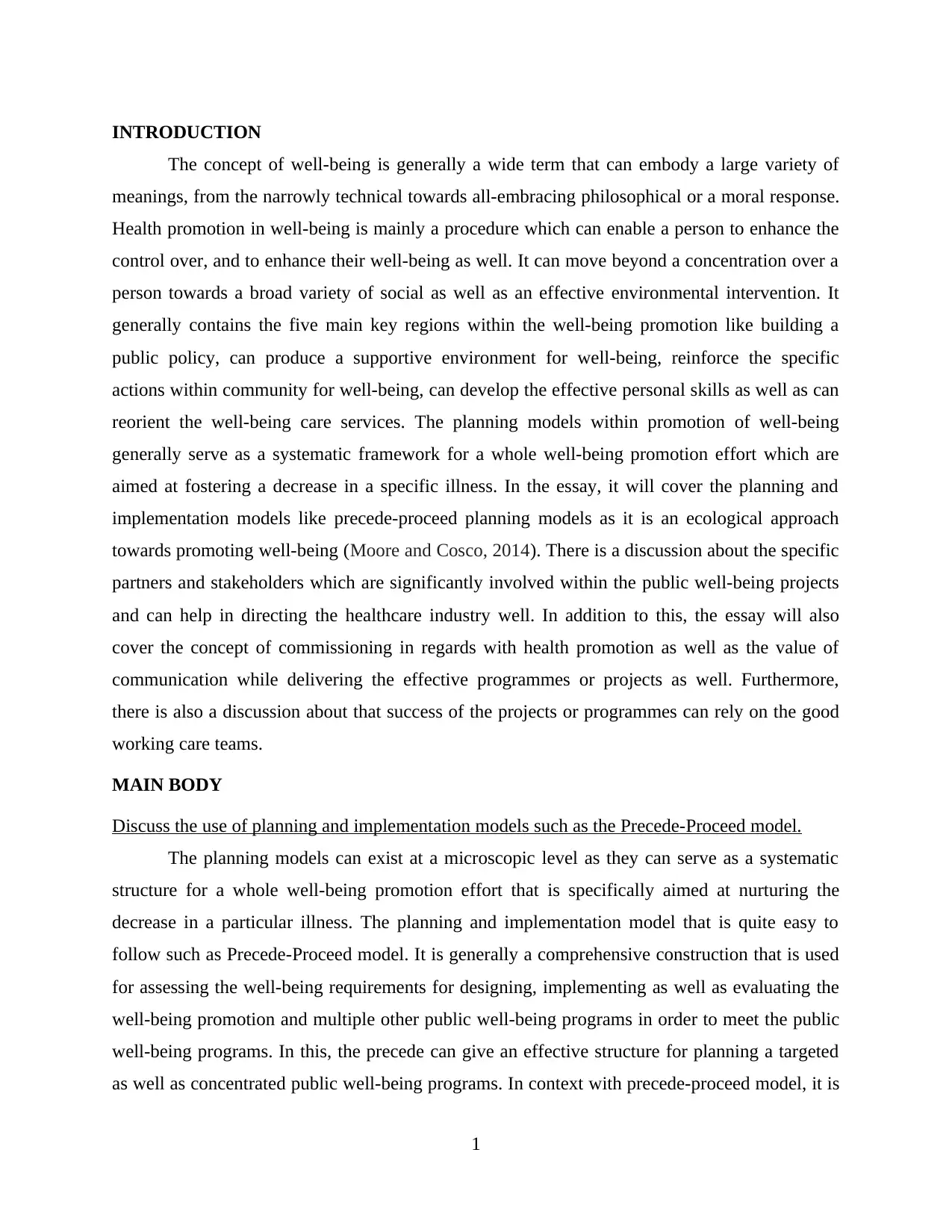
INTRODUCTION
The concept of well-being is generally a wide term that can embody a large variety of
meanings, from the narrowly technical towards all-embracing philosophical or a moral response.
Health promotion in well-being is mainly a procedure which can enable a person to enhance the
control over, and to enhance their well-being as well. It can move beyond a concentration over a
person towards a broad variety of social as well as an effective environmental intervention. It
generally contains the five main key regions within the well-being promotion like building a
public policy, can produce a supportive environment for well-being, reinforce the specific
actions within community for well-being, can develop the effective personal skills as well as can
reorient the well-being care services. The planning models within promotion of well-being
generally serve as a systematic framework for a whole well-being promotion effort which are
aimed at fostering a decrease in a specific illness. In the essay, it will cover the planning and
implementation models like precede-proceed planning models as it is an ecological approach
towards promoting well-being (Moore and Cosco, 2014). There is a discussion about the specific
partners and stakeholders which are significantly involved within the public well-being projects
and can help in directing the healthcare industry well. In addition to this, the essay will also
cover the concept of commissioning in regards with health promotion as well as the value of
communication while delivering the effective programmes or projects as well. Furthermore,
there is also a discussion about that success of the projects or programmes can rely on the good
working care teams.
MAIN BODY
Discuss the use of planning and implementation models such as the Precede-Proceed model.
The planning models can exist at a microscopic level as they can serve as a systematic
structure for a whole well-being promotion effort that is specifically aimed at nurturing the
decrease in a particular illness. The planning and implementation model that is quite easy to
follow such as Precede-Proceed model. It is generally a comprehensive construction that is used
for assessing the well-being requirements for designing, implementing as well as evaluating the
well-being promotion and multiple other public well-being programs in order to meet the public
well-being programs. In this, the precede can give an effective structure for planning a targeted
as well as concentrated public well-being programs. In context with precede-proceed model, it is
1
The concept of well-being is generally a wide term that can embody a large variety of
meanings, from the narrowly technical towards all-embracing philosophical or a moral response.
Health promotion in well-being is mainly a procedure which can enable a person to enhance the
control over, and to enhance their well-being as well. It can move beyond a concentration over a
person towards a broad variety of social as well as an effective environmental intervention. It
generally contains the five main key regions within the well-being promotion like building a
public policy, can produce a supportive environment for well-being, reinforce the specific
actions within community for well-being, can develop the effective personal skills as well as can
reorient the well-being care services. The planning models within promotion of well-being
generally serve as a systematic framework for a whole well-being promotion effort which are
aimed at fostering a decrease in a specific illness. In the essay, it will cover the planning and
implementation models like precede-proceed planning models as it is an ecological approach
towards promoting well-being (Moore and Cosco, 2014). There is a discussion about the specific
partners and stakeholders which are significantly involved within the public well-being projects
and can help in directing the healthcare industry well. In addition to this, the essay will also
cover the concept of commissioning in regards with health promotion as well as the value of
communication while delivering the effective programmes or projects as well. Furthermore,
there is also a discussion about that success of the projects or programmes can rely on the good
working care teams.
MAIN BODY
Discuss the use of planning and implementation models such as the Precede-Proceed model.
The planning models can exist at a microscopic level as they can serve as a systematic
structure for a whole well-being promotion effort that is specifically aimed at nurturing the
decrease in a particular illness. The planning and implementation model that is quite easy to
follow such as Precede-Proceed model. It is generally a comprehensive construction that is used
for assessing the well-being requirements for designing, implementing as well as evaluating the
well-being promotion and multiple other public well-being programs in order to meet the public
well-being programs. In this, the precede can give an effective structure for planning a targeted
as well as concentrated public well-being programs. In context with precede-proceed model, it is
1
⊘ This is a preview!⊘
Do you want full access?
Subscribe today to unlock all pages.

Trusted by 1+ million students worldwide
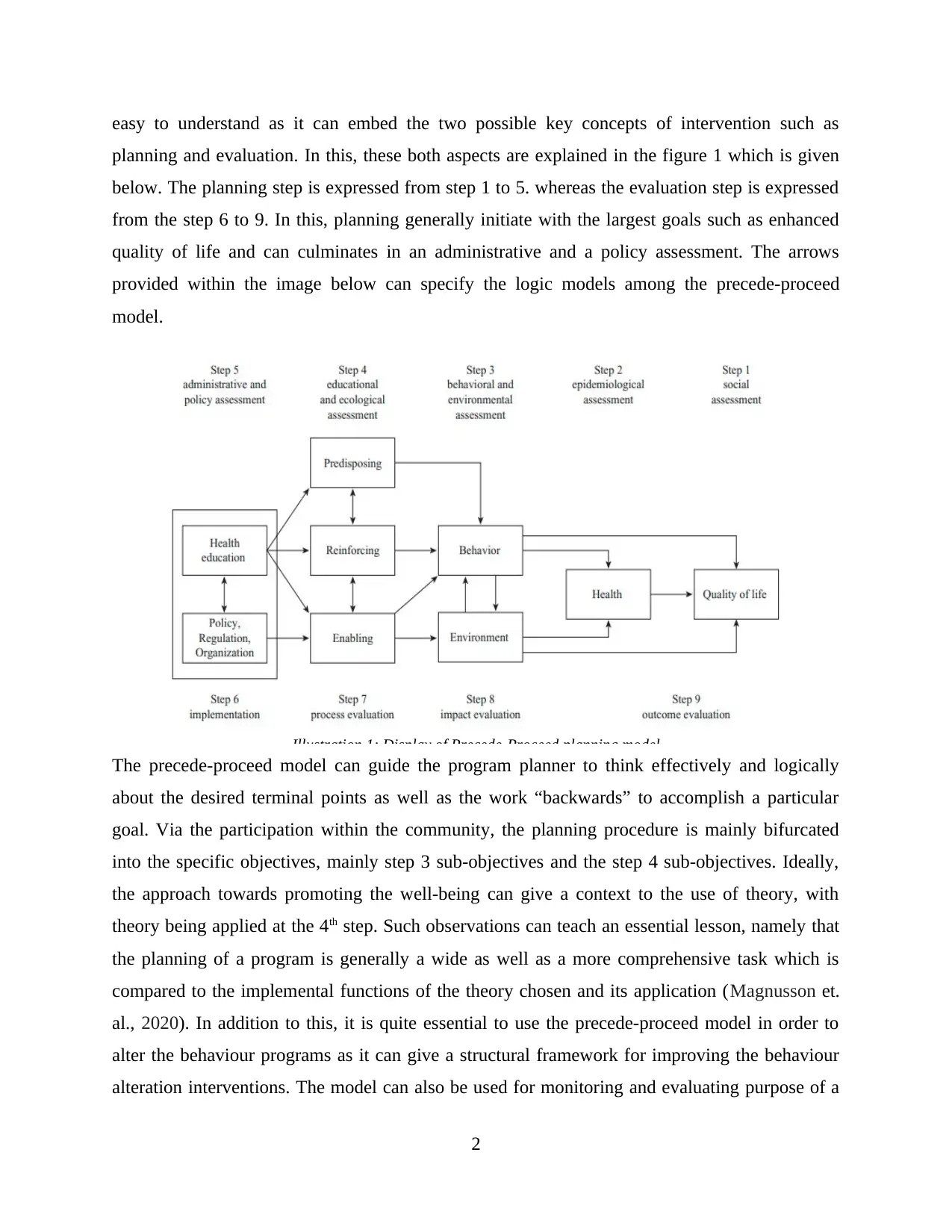
easy to understand as it can embed the two possible key concepts of intervention such as
planning and evaluation. In this, these both aspects are explained in the figure 1 which is given
below. The planning step is expressed from step 1 to 5. whereas the evaluation step is expressed
from the step 6 to 9. In this, planning generally initiate with the largest goals such as enhanced
quality of life and can culminates in an administrative and a policy assessment. The arrows
provided within the image below can specify the logic models among the precede-proceed
model.
The precede-proceed model can guide the program planner to think effectively and logically
about the desired terminal points as well as the work “backwards” to accomplish a particular
goal. Via the participation within the community, the planning procedure is mainly bifurcated
into the specific objectives, mainly step 3 sub-objectives and the step 4 sub-objectives. Ideally,
the approach towards promoting the well-being can give a context to the use of theory, with
theory being applied at the 4th step. Such observations can teach an essential lesson, namely that
the planning of a program is generally a wide as well as a more comprehensive task which is
compared to the implemental functions of the theory chosen and its application (Magnusson et.
al., 2020). In addition to this, it is quite essential to use the precede-proceed model in order to
alter the behaviour programs as it can give a structural framework for improving the behaviour
alteration interventions. The model can also be used for monitoring and evaluating purpose of a
2
Illustration 1: Display of Precede-Proceed planning model
planning and evaluation. In this, these both aspects are explained in the figure 1 which is given
below. The planning step is expressed from step 1 to 5. whereas the evaluation step is expressed
from the step 6 to 9. In this, planning generally initiate with the largest goals such as enhanced
quality of life and can culminates in an administrative and a policy assessment. The arrows
provided within the image below can specify the logic models among the precede-proceed
model.
The precede-proceed model can guide the program planner to think effectively and logically
about the desired terminal points as well as the work “backwards” to accomplish a particular
goal. Via the participation within the community, the planning procedure is mainly bifurcated
into the specific objectives, mainly step 3 sub-objectives and the step 4 sub-objectives. Ideally,
the approach towards promoting the well-being can give a context to the use of theory, with
theory being applied at the 4th step. Such observations can teach an essential lesson, namely that
the planning of a program is generally a wide as well as a more comprehensive task which is
compared to the implemental functions of the theory chosen and its application (Magnusson et.
al., 2020). In addition to this, it is quite essential to use the precede-proceed model in order to
alter the behaviour programs as it can give a structural framework for improving the behaviour
alteration interventions. The model can also be used for monitoring and evaluating purpose of a
2
Illustration 1: Display of Precede-Proceed planning model
Paraphrase This Document
Need a fresh take? Get an instant paraphrase of this document with our AI Paraphraser
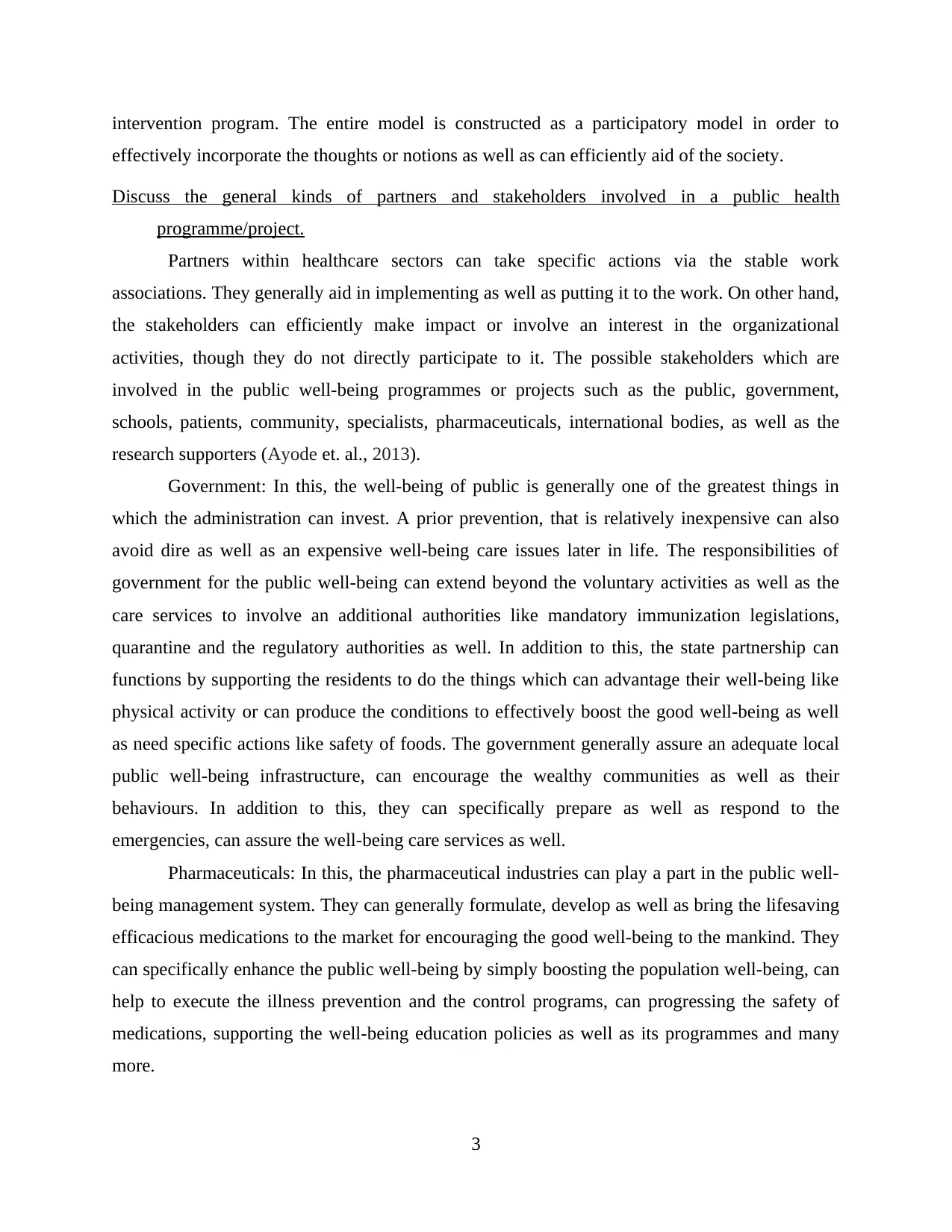
intervention program. The entire model is constructed as a participatory model in order to
effectively incorporate the thoughts or notions as well as can efficiently aid of the society.
Discuss the general kinds of partners and stakeholders involved in a public health
programme/project.
Partners within healthcare sectors can take specific actions via the stable work
associations. They generally aid in implementing as well as putting it to the work. On other hand,
the stakeholders can efficiently make impact or involve an interest in the organizational
activities, though they do not directly participate to it. The possible stakeholders which are
involved in the public well-being programmes or projects such as the public, government,
schools, patients, community, specialists, pharmaceuticals, international bodies, as well as the
research supporters (Ayode et. al., 2013).
Government: In this, the well-being of public is generally one of the greatest things in
which the administration can invest. A prior prevention, that is relatively inexpensive can also
avoid dire as well as an expensive well-being care issues later in life. The responsibilities of
government for the public well-being can extend beyond the voluntary activities as well as the
care services to involve an additional authorities like mandatory immunization legislations,
quarantine and the regulatory authorities as well. In addition to this, the state partnership can
functions by supporting the residents to do the things which can advantage their well-being like
physical activity or can produce the conditions to effectively boost the good well-being as well
as need specific actions like safety of foods. The government generally assure an adequate local
public well-being infrastructure, can encourage the wealthy communities as well as their
behaviours. In addition to this, they can specifically prepare as well as respond to the
emergencies, can assure the well-being care services as well.
Pharmaceuticals: In this, the pharmaceutical industries can play a part in the public well-
being management system. They can generally formulate, develop as well as bring the lifesaving
efficacious medications to the market for encouraging the good well-being to the mankind. They
can specifically enhance the public well-being by simply boosting the population well-being, can
help to execute the illness prevention and the control programs, can progressing the safety of
medications, supporting the well-being education policies as well as its programmes and many
more.
3
effectively incorporate the thoughts or notions as well as can efficiently aid of the society.
Discuss the general kinds of partners and stakeholders involved in a public health
programme/project.
Partners within healthcare sectors can take specific actions via the stable work
associations. They generally aid in implementing as well as putting it to the work. On other hand,
the stakeholders can efficiently make impact or involve an interest in the organizational
activities, though they do not directly participate to it. The possible stakeholders which are
involved in the public well-being programmes or projects such as the public, government,
schools, patients, community, specialists, pharmaceuticals, international bodies, as well as the
research supporters (Ayode et. al., 2013).
Government: In this, the well-being of public is generally one of the greatest things in
which the administration can invest. A prior prevention, that is relatively inexpensive can also
avoid dire as well as an expensive well-being care issues later in life. The responsibilities of
government for the public well-being can extend beyond the voluntary activities as well as the
care services to involve an additional authorities like mandatory immunization legislations,
quarantine and the regulatory authorities as well. In addition to this, the state partnership can
functions by supporting the residents to do the things which can advantage their well-being like
physical activity or can produce the conditions to effectively boost the good well-being as well
as need specific actions like safety of foods. The government generally assure an adequate local
public well-being infrastructure, can encourage the wealthy communities as well as their
behaviours. In addition to this, they can specifically prepare as well as respond to the
emergencies, can assure the well-being care services as well.
Pharmaceuticals: In this, the pharmaceutical industries can play a part in the public well-
being management system. They can generally formulate, develop as well as bring the lifesaving
efficacious medications to the market for encouraging the good well-being to the mankind. They
can specifically enhance the public well-being by simply boosting the population well-being, can
help to execute the illness prevention and the control programs, can progressing the safety of
medications, supporting the well-being education policies as well as its programmes and many
more.
3
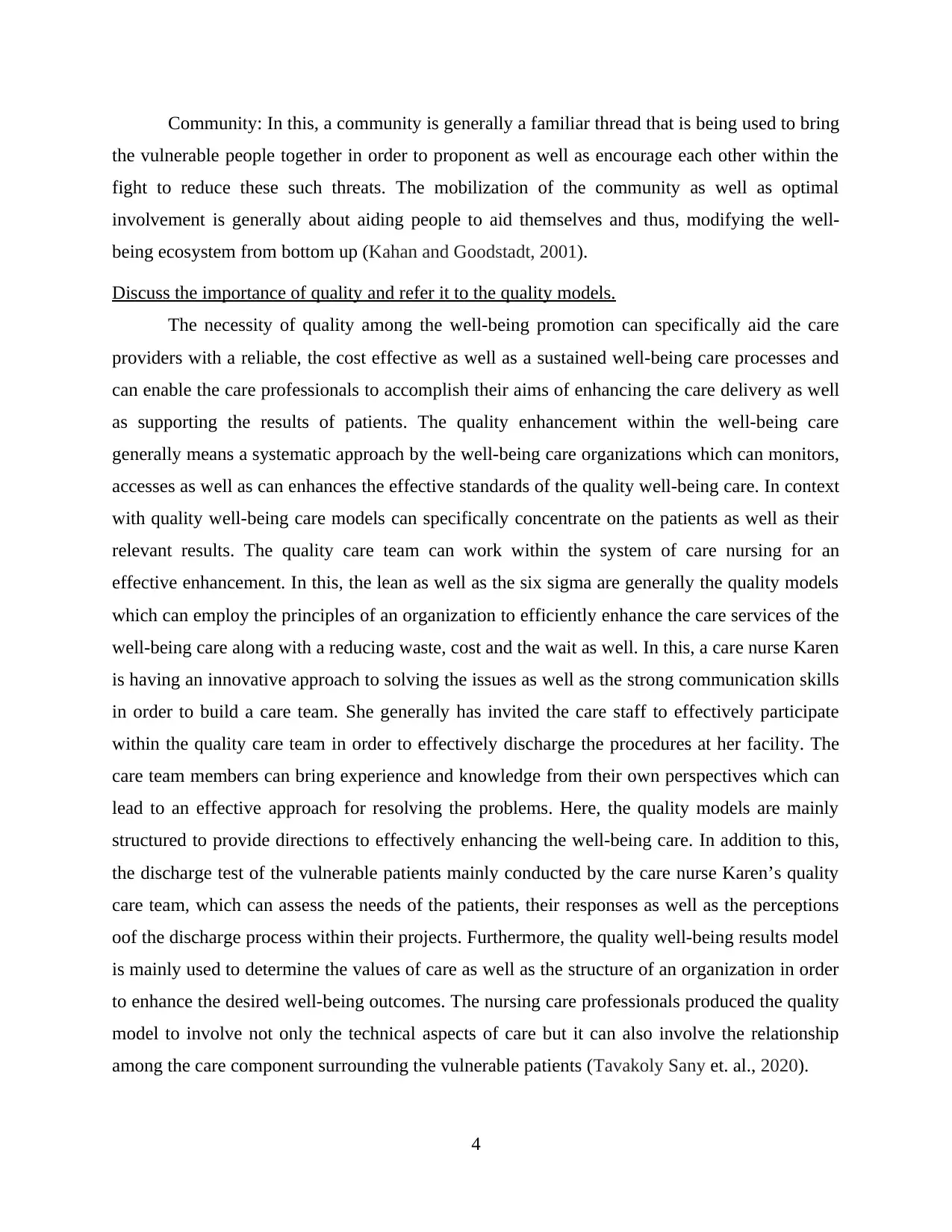
Community: In this, a community is generally a familiar thread that is being used to bring
the vulnerable people together in order to proponent as well as encourage each other within the
fight to reduce these such threats. The mobilization of the community as well as optimal
involvement is generally about aiding people to aid themselves and thus, modifying the well-
being ecosystem from bottom up (Kahan and Goodstadt, 2001).
Discuss the importance of quality and refer it to the quality models.
The necessity of quality among the well-being promotion can specifically aid the care
providers with a reliable, the cost effective as well as a sustained well-being care processes and
can enable the care professionals to accomplish their aims of enhancing the care delivery as well
as supporting the results of patients. The quality enhancement within the well-being care
generally means a systematic approach by the well-being care organizations which can monitors,
accesses as well as can enhances the effective standards of the quality well-being care. In context
with quality well-being care models can specifically concentrate on the patients as well as their
relevant results. The quality care team can work within the system of care nursing for an
effective enhancement. In this, the lean as well as the six sigma are generally the quality models
which can employ the principles of an organization to efficiently enhance the care services of the
well-being care along with a reducing waste, cost and the wait as well. In this, a care nurse Karen
is having an innovative approach to solving the issues as well as the strong communication skills
in order to build a care team. She generally has invited the care staff to effectively participate
within the quality care team in order to effectively discharge the procedures at her facility. The
care team members can bring experience and knowledge from their own perspectives which can
lead to an effective approach for resolving the problems. Here, the quality models are mainly
structured to provide directions to effectively enhancing the well-being care. In addition to this,
the discharge test of the vulnerable patients mainly conducted by the care nurse Karen’s quality
care team, which can assess the needs of the patients, their responses as well as the perceptions
oof the discharge process within their projects. Furthermore, the quality well-being results model
is mainly used to determine the values of care as well as the structure of an organization in order
to enhance the desired well-being outcomes. The nursing care professionals produced the quality
model to involve not only the technical aspects of care but it can also involve the relationship
among the care component surrounding the vulnerable patients (Tavakoly Sany et. al., 2020).
4
the vulnerable people together in order to proponent as well as encourage each other within the
fight to reduce these such threats. The mobilization of the community as well as optimal
involvement is generally about aiding people to aid themselves and thus, modifying the well-
being ecosystem from bottom up (Kahan and Goodstadt, 2001).
Discuss the importance of quality and refer it to the quality models.
The necessity of quality among the well-being promotion can specifically aid the care
providers with a reliable, the cost effective as well as a sustained well-being care processes and
can enable the care professionals to accomplish their aims of enhancing the care delivery as well
as supporting the results of patients. The quality enhancement within the well-being care
generally means a systematic approach by the well-being care organizations which can monitors,
accesses as well as can enhances the effective standards of the quality well-being care. In context
with quality well-being care models can specifically concentrate on the patients as well as their
relevant results. The quality care team can work within the system of care nursing for an
effective enhancement. In this, the lean as well as the six sigma are generally the quality models
which can employ the principles of an organization to efficiently enhance the care services of the
well-being care along with a reducing waste, cost and the wait as well. In this, a care nurse Karen
is having an innovative approach to solving the issues as well as the strong communication skills
in order to build a care team. She generally has invited the care staff to effectively participate
within the quality care team in order to effectively discharge the procedures at her facility. The
care team members can bring experience and knowledge from their own perspectives which can
lead to an effective approach for resolving the problems. Here, the quality models are mainly
structured to provide directions to effectively enhancing the well-being care. In addition to this,
the discharge test of the vulnerable patients mainly conducted by the care nurse Karen’s quality
care team, which can assess the needs of the patients, their responses as well as the perceptions
oof the discharge process within their projects. Furthermore, the quality well-being results model
is mainly used to determine the values of care as well as the structure of an organization in order
to enhance the desired well-being outcomes. The nursing care professionals produced the quality
model to involve not only the technical aspects of care but it can also involve the relationship
among the care component surrounding the vulnerable patients (Tavakoly Sany et. al., 2020).
4
⊘ This is a preview!⊘
Do you want full access?
Subscribe today to unlock all pages.

Trusted by 1+ million students worldwide
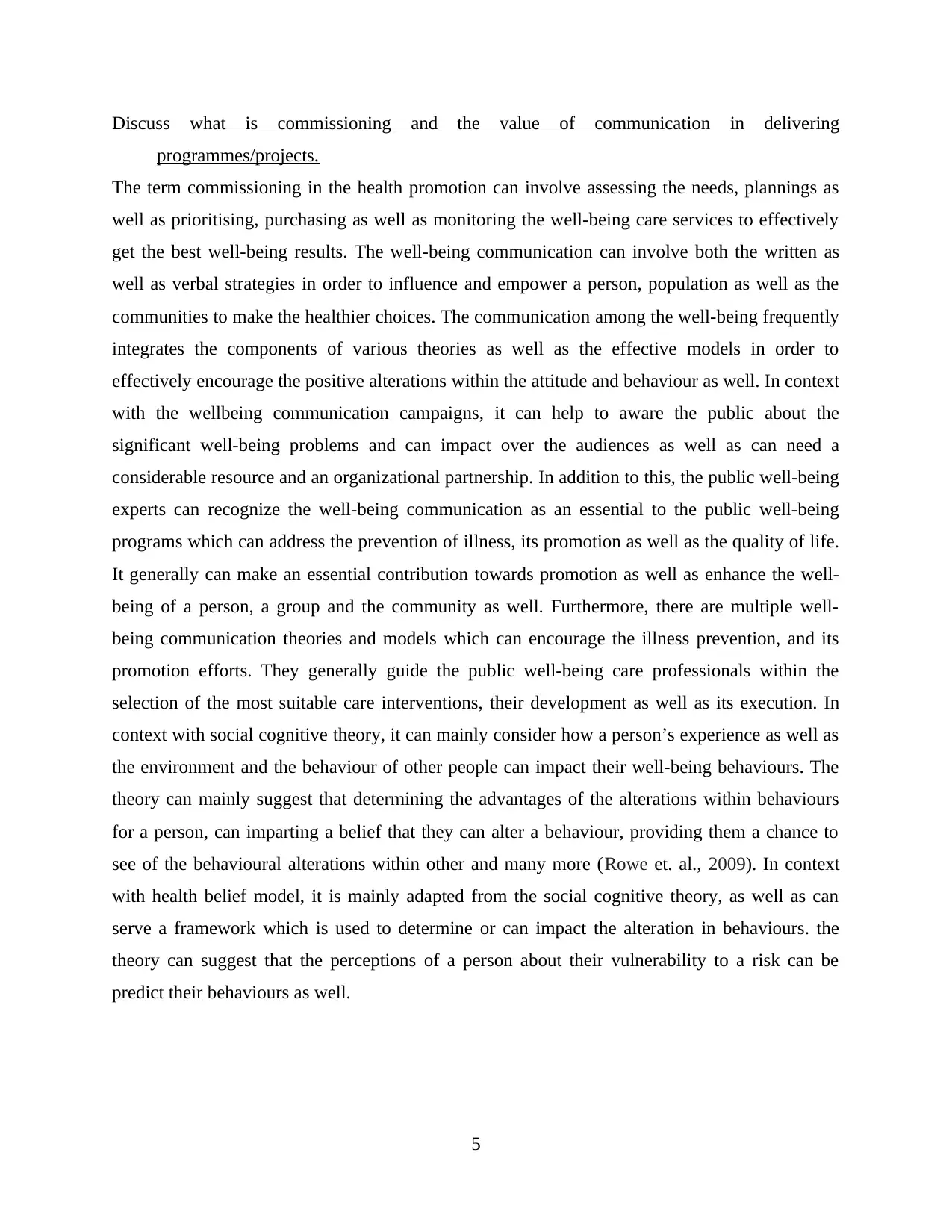
Discuss what is commissioning and the value of communication in delivering
programmes/projects.
The term commissioning in the health promotion can involve assessing the needs, plannings as
well as prioritising, purchasing as well as monitoring the well-being care services to effectively
get the best well-being results. The well-being communication can involve both the written as
well as verbal strategies in order to influence and empower a person, population as well as the
communities to make the healthier choices. The communication among the well-being frequently
integrates the components of various theories as well as the effective models in order to
effectively encourage the positive alterations within the attitude and behaviour as well. In context
with the wellbeing communication campaigns, it can help to aware the public about the
significant well-being problems and can impact over the audiences as well as can need a
considerable resource and an organizational partnership. In addition to this, the public well-being
experts can recognize the well-being communication as an essential to the public well-being
programs which can address the prevention of illness, its promotion as well as the quality of life.
It generally can make an essential contribution towards promotion as well as enhance the well-
being of a person, a group and the community as well. Furthermore, there are multiple well-
being communication theories and models which can encourage the illness prevention, and its
promotion efforts. They generally guide the public well-being care professionals within the
selection of the most suitable care interventions, their development as well as its execution. In
context with social cognitive theory, it can mainly consider how a person’s experience as well as
the environment and the behaviour of other people can impact their well-being behaviours. The
theory can mainly suggest that determining the advantages of the alterations within behaviours
for a person, can imparting a belief that they can alter a behaviour, providing them a chance to
see of the behavioural alterations within other and many more (Rowe et. al., 2009). In context
with health belief model, it is mainly adapted from the social cognitive theory, as well as can
serve a framework which is used to determine or can impact the alteration in behaviours. the
theory can suggest that the perceptions of a person about their vulnerability to a risk can be
predict their behaviours as well.
5
programmes/projects.
The term commissioning in the health promotion can involve assessing the needs, plannings as
well as prioritising, purchasing as well as monitoring the well-being care services to effectively
get the best well-being results. The well-being communication can involve both the written as
well as verbal strategies in order to influence and empower a person, population as well as the
communities to make the healthier choices. The communication among the well-being frequently
integrates the components of various theories as well as the effective models in order to
effectively encourage the positive alterations within the attitude and behaviour as well. In context
with the wellbeing communication campaigns, it can help to aware the public about the
significant well-being problems and can impact over the audiences as well as can need a
considerable resource and an organizational partnership. In addition to this, the public well-being
experts can recognize the well-being communication as an essential to the public well-being
programs which can address the prevention of illness, its promotion as well as the quality of life.
It generally can make an essential contribution towards promotion as well as enhance the well-
being of a person, a group and the community as well. Furthermore, there are multiple well-
being communication theories and models which can encourage the illness prevention, and its
promotion efforts. They generally guide the public well-being care professionals within the
selection of the most suitable care interventions, their development as well as its execution. In
context with social cognitive theory, it can mainly consider how a person’s experience as well as
the environment and the behaviour of other people can impact their well-being behaviours. The
theory can mainly suggest that determining the advantages of the alterations within behaviours
for a person, can imparting a belief that they can alter a behaviour, providing them a chance to
see of the behavioural alterations within other and many more (Rowe et. al., 2009). In context
with health belief model, it is mainly adapted from the social cognitive theory, as well as can
serve a framework which is used to determine or can impact the alteration in behaviours. the
theory can suggest that the perceptions of a person about their vulnerability to a risk can be
predict their behaviours as well.
5
Paraphrase This Document
Need a fresh take? Get an instant paraphrase of this document with our AI Paraphraser
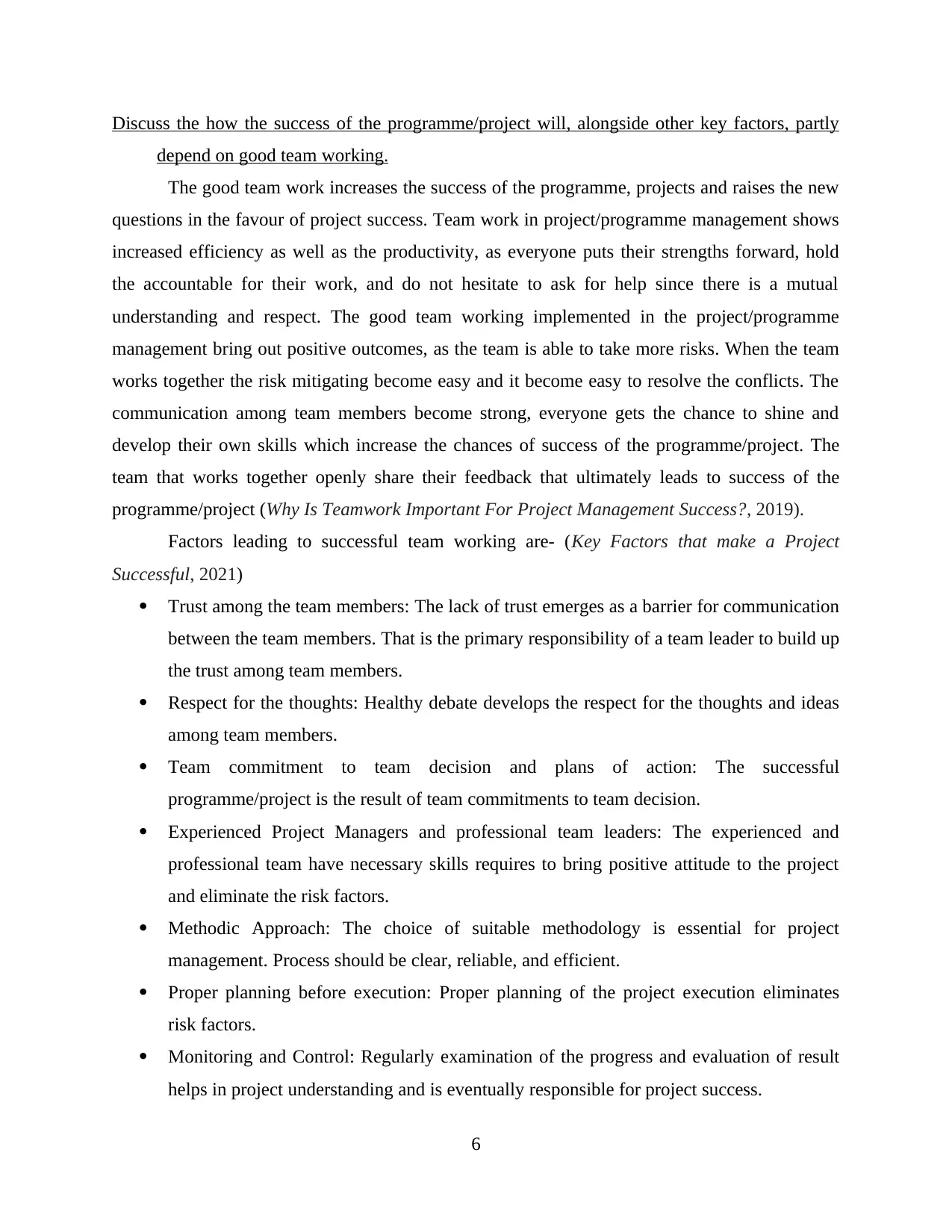
Discuss the how the success of the programme/project will, alongside other key factors, partly
depend on good team working.
The good team work increases the success of the programme, projects and raises the new
questions in the favour of project success. Team work in project/programme management shows
increased efficiency as well as the productivity, as everyone puts their strengths forward, hold
the accountable for their work, and do not hesitate to ask for help since there is a mutual
understanding and respect. The good team working implemented in the project/programme
management bring out positive outcomes, as the team is able to take more risks. When the team
works together the risk mitigating become easy and it become easy to resolve the conflicts. The
communication among team members become strong, everyone gets the chance to shine and
develop their own skills which increase the chances of success of the programme/project. The
team that works together openly share their feedback that ultimately leads to success of the
programme/project (Why Is Teamwork Important For Project Management Success?, 2019).
Factors leading to successful team working are- (Key Factors that make a Project
Successful, 2021)
Trust among the team members: The lack of trust emerges as a barrier for communication
between the team members. That is the primary responsibility of a team leader to build up
the trust among team members.
Respect for the thoughts: Healthy debate develops the respect for the thoughts and ideas
among team members.
Team commitment to team decision and plans of action: The successful
programme/project is the result of team commitments to team decision.
Experienced Project Managers and professional team leaders: The experienced and
professional team have necessary skills requires to bring positive attitude to the project
and eliminate the risk factors.
Methodic Approach: The choice of suitable methodology is essential for project
management. Process should be clear, reliable, and efficient.
Proper planning before execution: Proper planning of the project execution eliminates
risk factors.
Monitoring and Control: Regularly examination of the progress and evaluation of result
helps in project understanding and is eventually responsible for project success.
6
depend on good team working.
The good team work increases the success of the programme, projects and raises the new
questions in the favour of project success. Team work in project/programme management shows
increased efficiency as well as the productivity, as everyone puts their strengths forward, hold
the accountable for their work, and do not hesitate to ask for help since there is a mutual
understanding and respect. The good team working implemented in the project/programme
management bring out positive outcomes, as the team is able to take more risks. When the team
works together the risk mitigating become easy and it become easy to resolve the conflicts. The
communication among team members become strong, everyone gets the chance to shine and
develop their own skills which increase the chances of success of the programme/project. The
team that works together openly share their feedback that ultimately leads to success of the
programme/project (Why Is Teamwork Important For Project Management Success?, 2019).
Factors leading to successful team working are- (Key Factors that make a Project
Successful, 2021)
Trust among the team members: The lack of trust emerges as a barrier for communication
between the team members. That is the primary responsibility of a team leader to build up
the trust among team members.
Respect for the thoughts: Healthy debate develops the respect for the thoughts and ideas
among team members.
Team commitment to team decision and plans of action: The successful
programme/project is the result of team commitments to team decision.
Experienced Project Managers and professional team leaders: The experienced and
professional team have necessary skills requires to bring positive attitude to the project
and eliminate the risk factors.
Methodic Approach: The choice of suitable methodology is essential for project
management. Process should be clear, reliable, and efficient.
Proper planning before execution: Proper planning of the project execution eliminates
risk factors.
Monitoring and Control: Regularly examination of the progress and evaluation of result
helps in project understanding and is eventually responsible for project success.
6
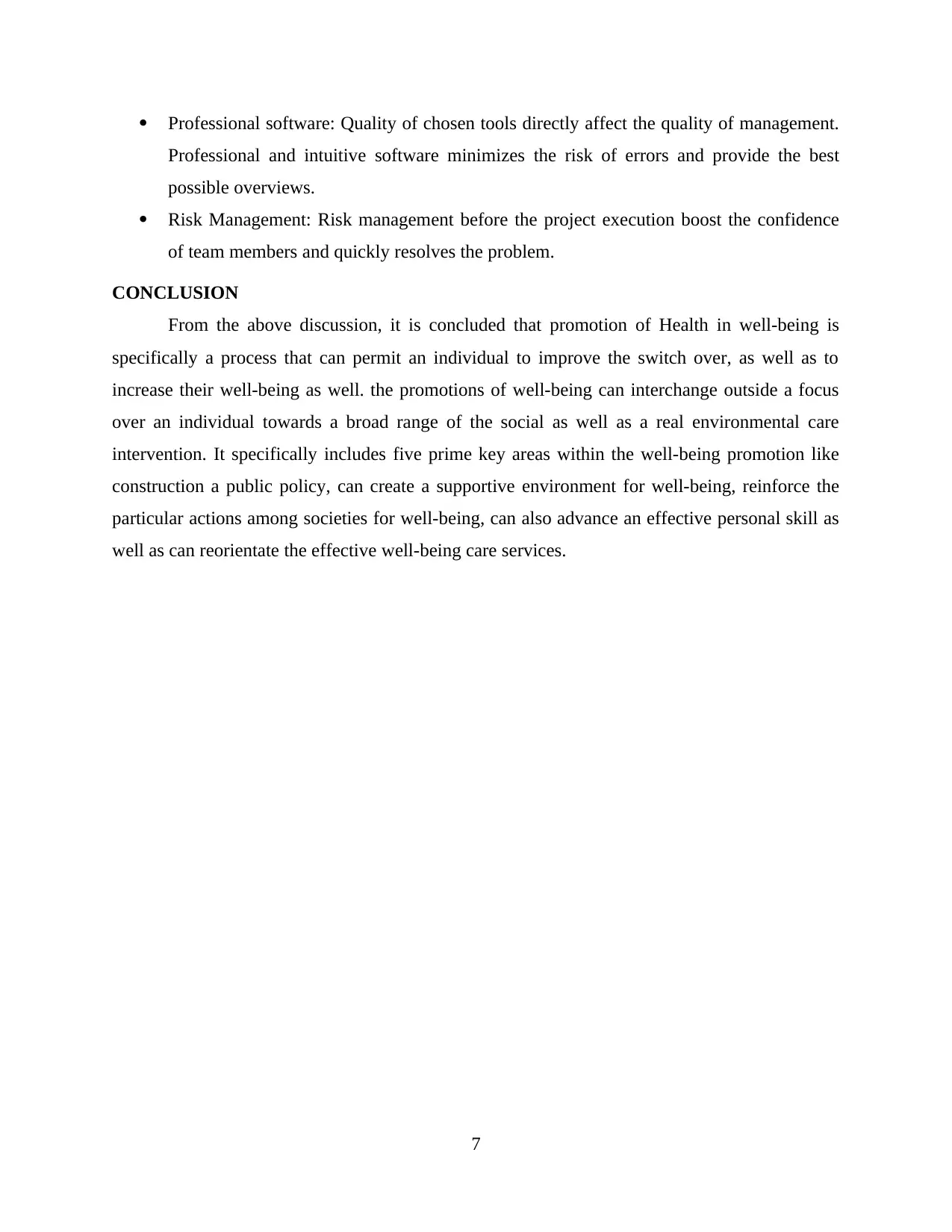
Professional software: Quality of chosen tools directly affect the quality of management.
Professional and intuitive software minimizes the risk of errors and provide the best
possible overviews.
Risk Management: Risk management before the project execution boost the confidence
of team members and quickly resolves the problem.
CONCLUSION
From the above discussion, it is concluded that promotion of Health in well-being is
specifically a process that can permit an individual to improve the switch over, as well as to
increase their well-being as well. the promotions of well-being can interchange outside a focus
over an individual towards a broad range of the social as well as a real environmental care
intervention. It specifically includes five prime key areas within the well-being promotion like
construction a public policy, can create a supportive environment for well-being, reinforce the
particular actions among societies for well-being, can also advance an effective personal skill as
well as can reorientate the effective well-being care services.
7
Professional and intuitive software minimizes the risk of errors and provide the best
possible overviews.
Risk Management: Risk management before the project execution boost the confidence
of team members and quickly resolves the problem.
CONCLUSION
From the above discussion, it is concluded that promotion of Health in well-being is
specifically a process that can permit an individual to improve the switch over, as well as to
increase their well-being as well. the promotions of well-being can interchange outside a focus
over an individual towards a broad range of the social as well as a real environmental care
intervention. It specifically includes five prime key areas within the well-being promotion like
construction a public policy, can create a supportive environment for well-being, reinforce the
particular actions among societies for well-being, can also advance an effective personal skill as
well as can reorientate the effective well-being care services.
7
⊘ This is a preview!⊘
Do you want full access?
Subscribe today to unlock all pages.

Trusted by 1+ million students worldwide
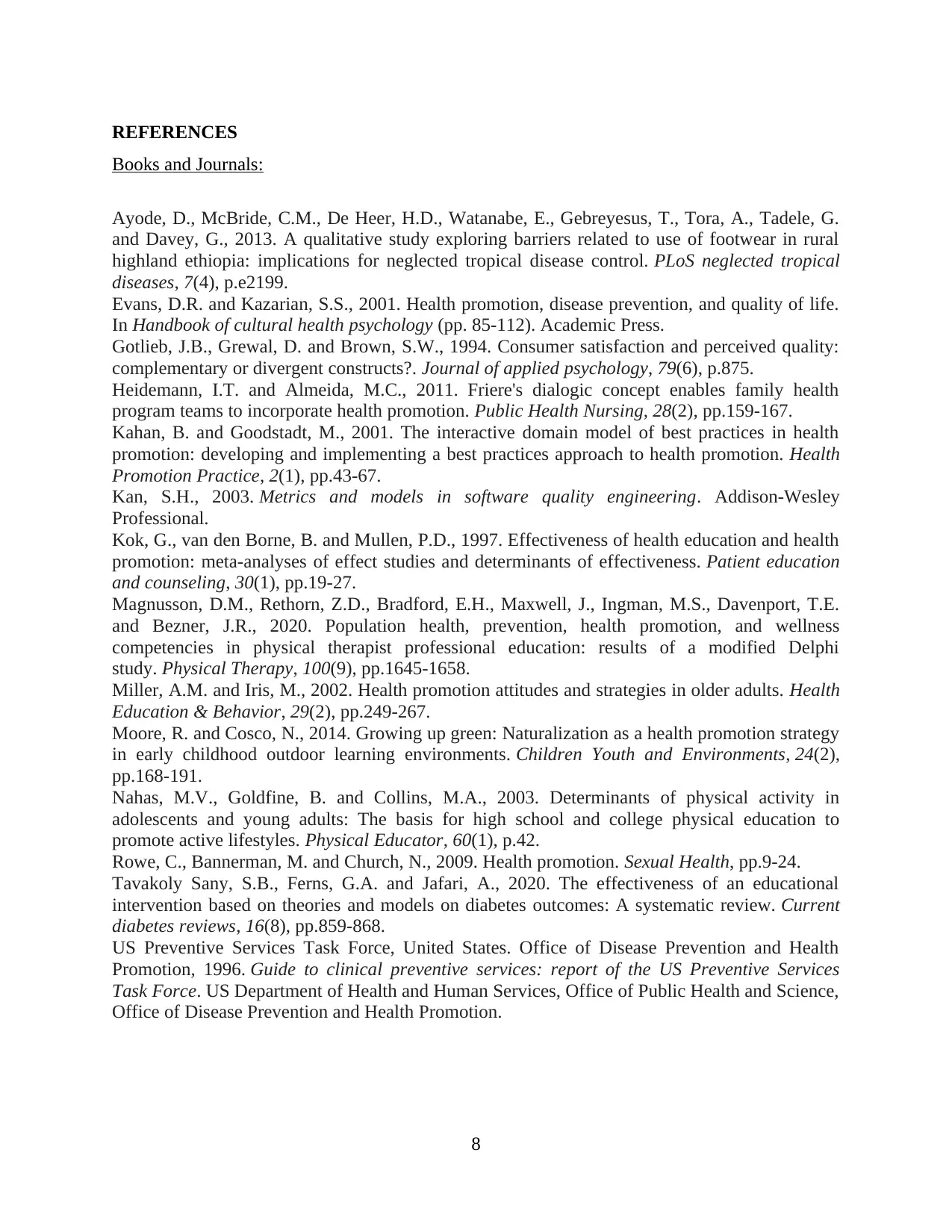
REFERENCES
Books and Journals:
Ayode, D., McBride, C.M., De Heer, H.D., Watanabe, E., Gebreyesus, T., Tora, A., Tadele, G.
and Davey, G., 2013. A qualitative study exploring barriers related to use of footwear in rural
highland ethiopia: implications for neglected tropical disease control. PLoS neglected tropical
diseases, 7(4), p.e2199.
Evans, D.R. and Kazarian, S.S., 2001. Health promotion, disease prevention, and quality of life.
In Handbook of cultural health psychology (pp. 85-112). Academic Press.
Gotlieb, J.B., Grewal, D. and Brown, S.W., 1994. Consumer satisfaction and perceived quality:
complementary or divergent constructs?. Journal of applied psychology, 79(6), p.875.
Heidemann, I.T. and Almeida, M.C., 2011. Friere's dialogic concept enables family health
program teams to incorporate health promotion. Public Health Nursing, 28(2), pp.159-167.
Kahan, B. and Goodstadt, M., 2001. The interactive domain model of best practices in health
promotion: developing and implementing a best practices approach to health promotion. Health
Promotion Practice, 2(1), pp.43-67.
Kan, S.H., 2003. Metrics and models in software quality engineering. Addison-Wesley
Professional.
Kok, G., van den Borne, B. and Mullen, P.D., 1997. Effectiveness of health education and health
promotion: meta-analyses of effect studies and determinants of effectiveness. Patient education
and counseling, 30(1), pp.19-27.
Magnusson, D.M., Rethorn, Z.D., Bradford, E.H., Maxwell, J., Ingman, M.S., Davenport, T.E.
and Bezner, J.R., 2020. Population health, prevention, health promotion, and wellness
competencies in physical therapist professional education: results of a modified Delphi
study. Physical Therapy, 100(9), pp.1645-1658.
Miller, A.M. and Iris, M., 2002. Health promotion attitudes and strategies in older adults. Health
Education & Behavior, 29(2), pp.249-267.
Moore, R. and Cosco, N., 2014. Growing up green: Naturalization as a health promotion strategy
in early childhood outdoor learning environments. Children Youth and Environments, 24(2),
pp.168-191.
Nahas, M.V., Goldfine, B. and Collins, M.A., 2003. Determinants of physical activity in
adolescents and young adults: The basis for high school and college physical education to
promote active lifestyles. Physical Educator, 60(1), p.42.
Rowe, C., Bannerman, M. and Church, N., 2009. Health promotion. Sexual Health, pp.9-24.
Tavakoly Sany, S.B., Ferns, G.A. and Jafari, A., 2020. The effectiveness of an educational
intervention based on theories and models on diabetes outcomes: A systematic review. Current
diabetes reviews, 16(8), pp.859-868.
US Preventive Services Task Force, United States. Office of Disease Prevention and Health
Promotion, 1996. Guide to clinical preventive services: report of the US Preventive Services
Task Force. US Department of Health and Human Services, Office of Public Health and Science,
Office of Disease Prevention and Health Promotion.
8
Books and Journals:
Ayode, D., McBride, C.M., De Heer, H.D., Watanabe, E., Gebreyesus, T., Tora, A., Tadele, G.
and Davey, G., 2013. A qualitative study exploring barriers related to use of footwear in rural
highland ethiopia: implications for neglected tropical disease control. PLoS neglected tropical
diseases, 7(4), p.e2199.
Evans, D.R. and Kazarian, S.S., 2001. Health promotion, disease prevention, and quality of life.
In Handbook of cultural health psychology (pp. 85-112). Academic Press.
Gotlieb, J.B., Grewal, D. and Brown, S.W., 1994. Consumer satisfaction and perceived quality:
complementary or divergent constructs?. Journal of applied psychology, 79(6), p.875.
Heidemann, I.T. and Almeida, M.C., 2011. Friere's dialogic concept enables family health
program teams to incorporate health promotion. Public Health Nursing, 28(2), pp.159-167.
Kahan, B. and Goodstadt, M., 2001. The interactive domain model of best practices in health
promotion: developing and implementing a best practices approach to health promotion. Health
Promotion Practice, 2(1), pp.43-67.
Kan, S.H., 2003. Metrics and models in software quality engineering. Addison-Wesley
Professional.
Kok, G., van den Borne, B. and Mullen, P.D., 1997. Effectiveness of health education and health
promotion: meta-analyses of effect studies and determinants of effectiveness. Patient education
and counseling, 30(1), pp.19-27.
Magnusson, D.M., Rethorn, Z.D., Bradford, E.H., Maxwell, J., Ingman, M.S., Davenport, T.E.
and Bezner, J.R., 2020. Population health, prevention, health promotion, and wellness
competencies in physical therapist professional education: results of a modified Delphi
study. Physical Therapy, 100(9), pp.1645-1658.
Miller, A.M. and Iris, M., 2002. Health promotion attitudes and strategies in older adults. Health
Education & Behavior, 29(2), pp.249-267.
Moore, R. and Cosco, N., 2014. Growing up green: Naturalization as a health promotion strategy
in early childhood outdoor learning environments. Children Youth and Environments, 24(2),
pp.168-191.
Nahas, M.V., Goldfine, B. and Collins, M.A., 2003. Determinants of physical activity in
adolescents and young adults: The basis for high school and college physical education to
promote active lifestyles. Physical Educator, 60(1), p.42.
Rowe, C., Bannerman, M. and Church, N., 2009. Health promotion. Sexual Health, pp.9-24.
Tavakoly Sany, S.B., Ferns, G.A. and Jafari, A., 2020. The effectiveness of an educational
intervention based on theories and models on diabetes outcomes: A systematic review. Current
diabetes reviews, 16(8), pp.859-868.
US Preventive Services Task Force, United States. Office of Disease Prevention and Health
Promotion, 1996. Guide to clinical preventive services: report of the US Preventive Services
Task Force. US Department of Health and Human Services, Office of Public Health and Science,
Office of Disease Prevention and Health Promotion.
8
Paraphrase This Document
Need a fresh take? Get an instant paraphrase of this document with our AI Paraphraser
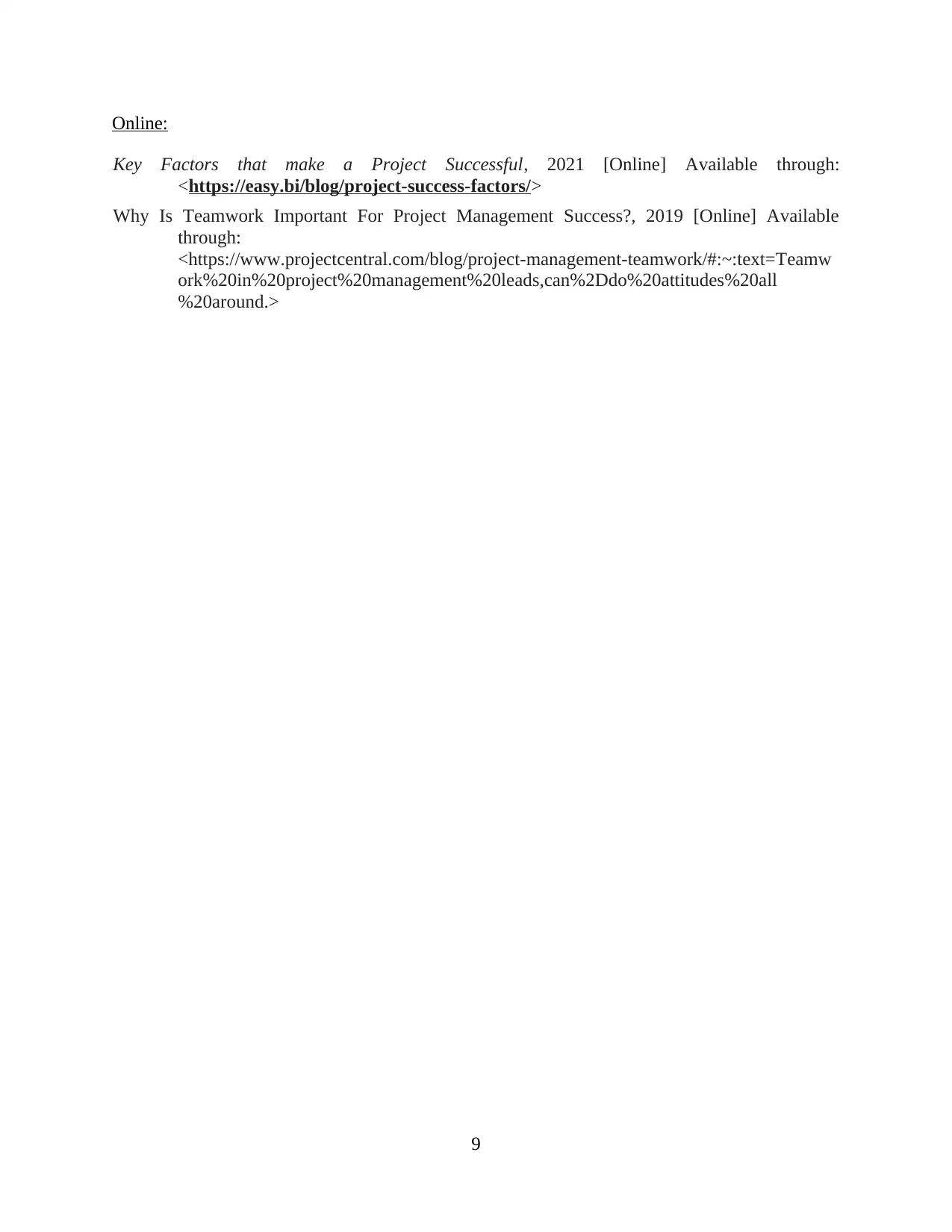
Online:
Key Factors that make a Project Successful, 2021 [Online] Available through:
<https://easy.bi/blog/project-success-factors/>
Why Is Teamwork Important For Project Management Success?, 2019 [Online] Available
through:
<https://www.projectcentral.com/blog/project-management-teamwork/#:~:text=Teamw
ork%20in%20project%20management%20leads,can%2Ddo%20attitudes%20all
%20around.>
9
Key Factors that make a Project Successful, 2021 [Online] Available through:
<https://easy.bi/blog/project-success-factors/>
Why Is Teamwork Important For Project Management Success?, 2019 [Online] Available
through:
<https://www.projectcentral.com/blog/project-management-teamwork/#:~:text=Teamw
ork%20in%20project%20management%20leads,can%2Ddo%20attitudes%20all
%20around.>
9
1 out of 11
Related Documents
Your All-in-One AI-Powered Toolkit for Academic Success.
+13062052269
info@desklib.com
Available 24*7 on WhatsApp / Email
![[object Object]](/_next/static/media/star-bottom.7253800d.svg)
Unlock your academic potential
Copyright © 2020–2025 A2Z Services. All Rights Reserved. Developed and managed by ZUCOL.



